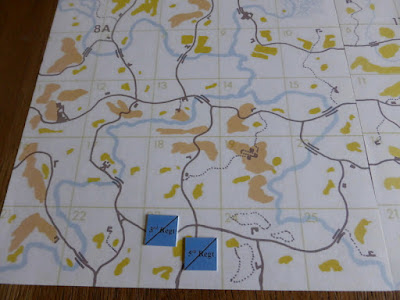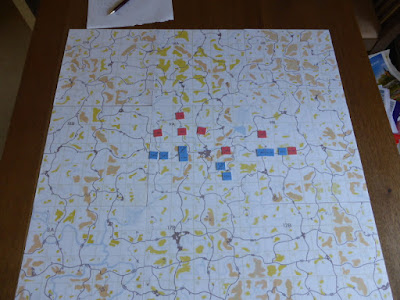As a bit of a refresher, both armies were closing towards each other around Offenburgh. The Prusskians had won the first major battle to the East of the capital, but the Ruthenians had been able to quit the field of battle, albeit in a rather battered and disordered state.
 |
| The positions at the end of Campaign Turn 4 |
With the orders in from both players for Campaign Turn 5, it was time to look at how they could be executed on the map, the outcome of which can be seen below.
 |
| The opening moves of Campaign Turn 5. Two battles that will take place can be seen to the North East and East of Offenburgh. |
The Ruthenian 3rd & 5th Cavalry have advanced and pushed back the
Prusskian 2nd Cavalry, who have had to retreat to 9A/7, where the Prusskian
1st Division has arrived to support the Light Infantry Battalion that
was guarding the bridge there. With their arrival, the 3rd & 5th
Cavalry have wisely chosen to 'observe' the enemy from a safe distance,
but are in a position to threaten one of the Prusskian Lines of
Communication. The Ruthenian 4th Division has moved to the South East of Offenburgh and is in a position to advance against the Prusskian right flank or move to assist the Ruthenian right flank as required.
The
Ruthenian 6th Division has pushed aggressively forward against the Prusskian 4th
Cavalry, who have retreated in the face of overwhelming force.
Fortunately the Prusskian 3rd Division has been sent to re-inforce them,
but they have to cross the river in order to do this. Will they arrive
in time or will the Ruthenians be able to defeat them in detail? Battle will be joined between these forces.
After
their recent victory, the Prusskian 5th Division and 6th Cavalry have
moved against the the Ruthenian 2nd Division and 1st Cavalry. The
Ruthenians moving to assist the 6th Divisions advance, have no choice but to halt in favourable terrain if possible,
to give battle to help protect the Ruthenian 6th Divisions advance.
One of their Brigades is still feeling the after effects of the previous battle and they their cavalry is weaker than the Prusskians. This could be a tough ask but if the terrain favours them, it might equal things up a bit. Again battle will be joined.
We have reached what might be the decisive battles of the campaign. I will play both out before posting the AAR's so not as to affect either players decisions in terms of deployment, tactics etc as the two battle are so close to each other. The first one, the Ruthenian 6th Divisions aggressive advance has been worked out in terms of the terrain to be fought over, which should be interesting. I just need to set the table up, send info to both players and hopefully fight the battle today.
There will be some radio silence for a bit on this campaign as outlined above, so until next time...





































































